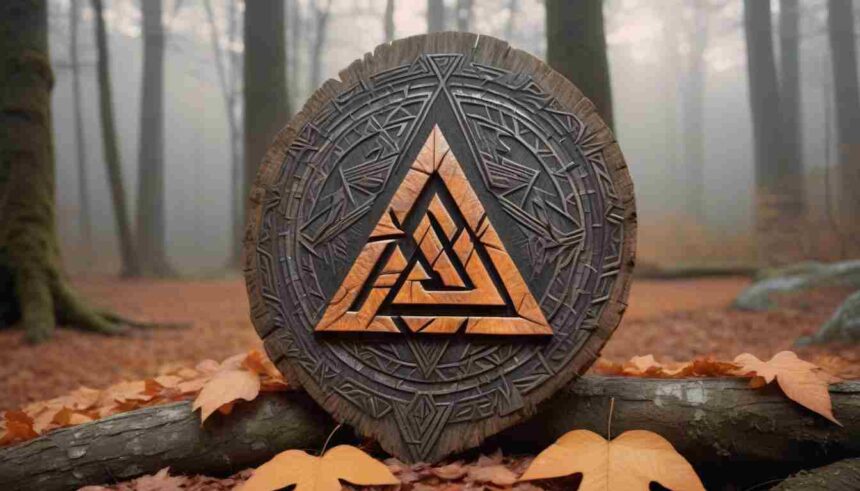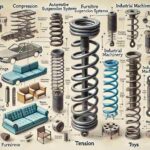The Valknut is a symbol that has intrigued many people, especially those interested in Norse mythology and Viking culture. This mysterious symbol is often associated with death, the afterlife, and Odin, one of the most important gods in Norse mythology.
What Is the Valknut?
The Valknut is a symbol that consists of three interlocked triangles. These triangles are often arranged in such a way that they form a shape that resembles a knot.
The name “Valknut” itself comes from two Old Norse words: “valr,” meaning “slain warrior,” and “knut,” meaning “knot.” Therefore, the Valknut symbol is often interpreted as the “knot of the slain warrior.”
This symbol can be found in various archaeological sites and artifacts, especially in Viking graves and burial sites. It has been carved into stones, jewelry, and other objects dating back to the Viking Age (around 793-1066 AD).
The Valknut is frequently seen alongside other Norse symbols, such as the Thor’s hammer (Mjölnir) and the wolf (often associated with the god Fenrir).
But what does this symbol represent, and why was it used by the Vikings?
The Valknut Meaning
The Valknut is generally associated with themes of death, transition, and the afterlife. It is often interpreted as a symbol that marks the passage from life to death, especially the death of warriors in battle.
The connection to warriors is key because, in Norse mythology, warriors who died in battle were believed to be chosen by the gods to join Odin in Valhalla, the hall of the slain.
Valhalla was a majestic hall in Asgard where Odin would welcome those warriors who had died bravely.
These warriors, known as the Einherjar, were honored and revered in Valhalla, where they would fight, feast, and prepare for the final battle during Ragnarok (the end of the world in Norse mythology). The Valknut, as a symbol, likely represented this transition to Valhalla or to the afterlife in general.
The three triangles of the Valknut may also represent the three realms of existence in Norse cosmology: the world of the living (Midgard), the world of the gods (Asgard), and the world of the dead (Helheim). This idea further reinforces the symbol’s association with death and the afterlife.
The Valknut and Its Connection to Odin
One of the most fascinating aspects of the Valknut is its strong connection to Odin, the chief god in Norse mythology. Odin was the god of war, death, poetry, and wisdom, among other things.
He was also known as the “Allfather” because he was believed to be the father of many gods, including Thor, the god of thunder, and Baldur, the god of beauty and love.
Odin’s role in the afterlife is crucial to understanding the Valknut’s connection to him. As the god who presided over Valhalla, Odin was the one who selected which warriors would enter his hall.
The Valknut symbol, which was often used in Viking burial practices, likely signified that the person buried with it had been chosen by Odin to join the ranks of the Einherjar in Valhalla.
Additionally, the Valknut’s three interlocking triangles may symbolize Odin’s own powers of creation and destruction. Odin is often depicted as a god who has both the power to give life and to take it away.
In Norse mythology, Odin sacrificed his own eye in exchange for wisdom and knowledge, and he was associated with the cycle of life and death. The Valknut, as a symbol tied to death and transition, may reflect Odin’s central role in these processes.
The Valknut in Norse Culture and Rituals
The Valknut was not just a symbol of death; it also had a profound cultural and ritualistic significance in Norse society. In Viking burials, the Valknut was often carved into gravestones or depicted on burial objects, such as shields, helmets, and swords.
It is believed that these symbols were used to honor the deceased and to ensure their safe passage to the afterlife, where they would be chosen by Odin to enter Valhalla.
The Valknut’s connection to Odin and the afterlife also suggests that the Vikings saw death as an important part of their existence.
The concept of dying honorably in battle and being chosen by Odin to live in Valhalla was a central belief for the Vikings. It is likely that the Valknut symbolized this noble death and the promise of a glorious afterlife with the gods.
Furthermore, the Valknut may have had magical or protective properties in Viking culture. Symbols like the Valknut were often thought to possess mystical powers that could protect the dead in their journey to the afterlife.
The presence of the Valknut on a burial stone could have been a way to invoke Odin’s protection and favor for the deceased.
The Valknut and Modern Interpretations
While the Valknut is primarily associated with Norse mythology and Viking culture, its meaning and symbolism have been interpreted in various ways in modern times.
For example, some people see the Valknut as a symbol of personal strength, resilience, and overcoming challenges. Others may view it as a symbol of connection to one’s ancestors or heritage, especially for those with Viking or Norse roots.
In modern paganism, particularly in Heathenry (a contemporary Norse pagan religion), the Valknut is often used as a symbol of the god Odin and his role in guiding the souls of the dead. Many Heathens wear the Valknut as a symbol of their devotion to Odin and their connection to the ancient Norse gods.
Some also view the Valknut as a symbol of the cycle of life and death. This interpretation connects the Valknut to the idea that life and death are intertwined and that death is not an end, but rather a transition to another phase of existence.
The Valknut, in this context, is seen as a representation of the cyclical nature of life and death, much like the seasons or the phases of the moon.
How to Use the Valknut Symbol
If you are interested in using the Valknut symbol, it is essential to understand its historical and cultural significance. Wearing the Valknut as jewelry or having it tattooed on your body can be a way to honor your Norse heritage or to connect with the god Odin and the ancient beliefs of the Vikings.
However, it is important to approach the Valknut symbol with respect for its cultural and religious roots. In Norse culture, the symbol was not just a decoration; it had deep spiritual and ritualistic meanings. Therefore, it is advisable to understand the symbolism behind the Valknut before incorporating it into your life, whether as a piece of jewelry, a tattoo, or a decorative item.






















